weight MERCEDES-BENZ GL SUV 2012 Owners Manual
[x] Cancel search | Manufacturer: MERCEDES-BENZ, Model Year: 2012, Model line: GL SUV, Model: MERCEDES-BENZ GL SUV 2012Pages: 441, PDF Size: 10.66 MB
Page 24 of 441
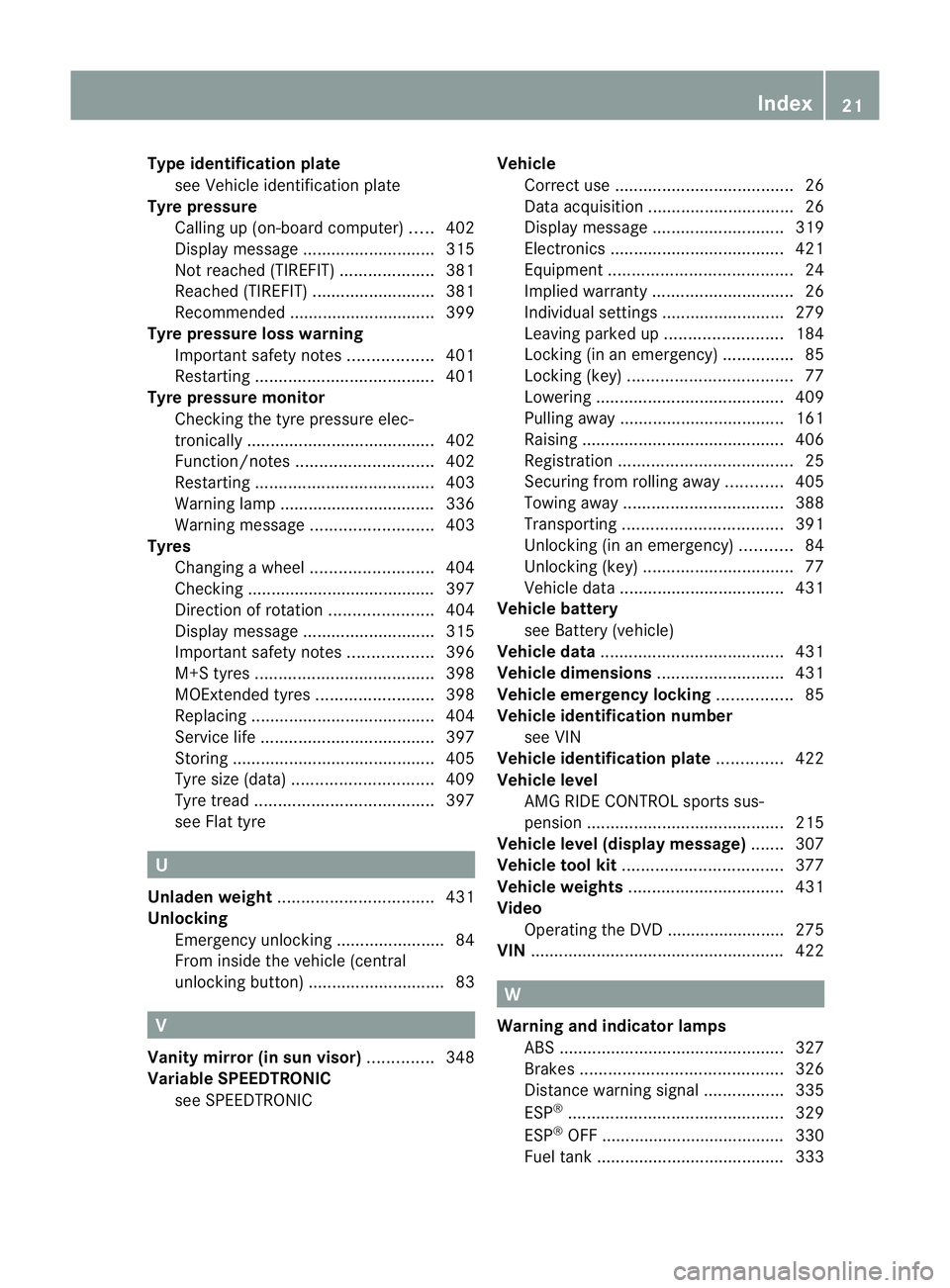
Type identificatio
nplate
see Vehicl eide ntificatio nplate
Tyr epressure
Calling up (on-board computer )..... 402
Display message ............................ 315
Not reac hed( TIREFIT) .................... 381
Reache d(TIREFIT) .......................... 381
Rec ommended ............................... 399
Tyre pressur elossw arning
Important safety notes ..................401
Restarting ...................................... 401
Tyre pressure mon itor
Checking the tyre pressure elec-
tronically ........................................ 402
Function/notes ............................. 402
Restarting ...................................... 403
Warn ingl am p................................. 336
Warning mess age. ......................... 403
Tyres
Changing awheel .......................... 404
Ch ecking ........................................ 397
Directio nofrotation ...................... 404
Display message ............................ 315
Important safety notes ..................396
M+S tyre s...................................... 398
MOExtende dtyres ......................... 398
Replacing ....................................... 404
Service life ..................................... 397
Storing ........................................... 405
Tyr esize (data) .............................. 409
Tyr etrea d...................................... 397
se eF lat tyre U
Unladen weight ................................. 431
Un lock ing
Emergency unlocking .......................84
From insid ethe vehicle (central
unl ocking button) ............................. 83 V
Vanity mirror (in sun visor) ..............348
Variable SP EEDTRONIC
se eS PEEDTRONIC Vehicle
Corr ectu se ...................................... 26
Data acq uisition ............................... 26
Display message ............................ 319
Electronics ..................................... 421
Equ ipment ....................................... 24
Implie dwarranty .............................. 26
Individua lsettings .......................... 279
Leaving pa rkedup. ........................ 184
Locking (i nanemergency) ............... 85
Locking (ke y)................................... 77
Lowering ........................................ 409
Pullin gaway................................... 161
Rais ing. .......................................... 406
Registratio n..................................... 25
Securing from rol ling away ............ 405
To wing away .................................. 388
Transporting .................................. 391
Unlockin g(in an emergency) ...........84
Unlockin g(key )................................ 77
Veh icle data ................................... 431
Vehi cleb attery
se eB attery (vehicle)
Vehicle data ....................................... 431
Vehi cled imensions ........................... 431
Vehi clee mergency locking ................85
Vehi clei dentification number
se eV IN
Vehi clei dentification plate ..............422
Vehi clel evel
AMG RIDE CONTROL sports sus-
pension .......................................... 215
Vehi clel evel (display message) .......307
Vehi clet ool kit .................................. 377
Vehi clew eights ................................. 431
Video Operating the DVD ......................... 275
VIN ...................................................... 422 W
Warning and indicator lamps ABS ................................................ 327
Brake s........................................... 326
Distance warning signa l................. 335
ESP ®
.............................................. 329
ESP ®
OFF ....................................... 330
Fue ltank ........................................ 333 Index
21
Page 26 of 441
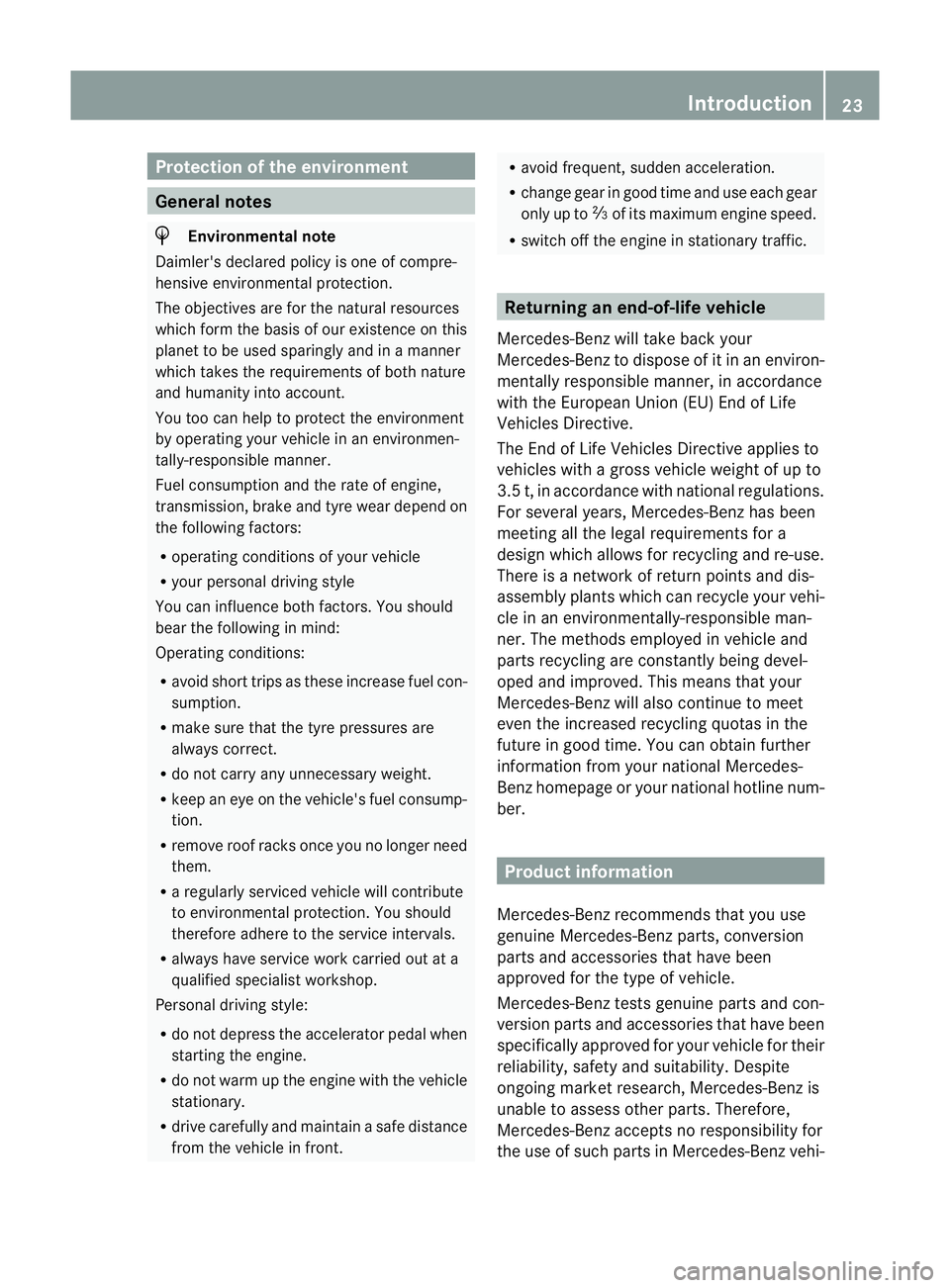
Protection of th
eenvironment Genera
lnotes H
Environmental note
Daimler's declared policy is one of compre-
hensive environmental protection.
The objectives are for the natural resources
which form the basis of our existence on this
planet to be used sparingly and in amanner
which takes the requirements of both nature
and humanity into account.
You too can help to protect the environment
by operating your vehicle in an environmen-
tally-responsible manner.
Fuel consumption and the rate of engine,
transmission, brake and tyre wear depend on
the following factors:
R operating conditions of your vehicle
R your personal driving style
You can influence both factors. You should
bear the following in mind:
Operating conditions:
R avoid short trips as these increase fuel con-
sumption.
R make sure that the tyre pressures are
always correct.
R do not carr yany unnecessary weight.
R keep an eye on the vehicle's fuel consump-
tion.
R remove roof racks once you no longer need
them.
R ar egularly serviced vehicle will contribute
to environmental protec tion. You should
therefor eadhere to the service inter vals.
R always have service work carried out at a
qualified specialist workshop.
Personal drivin gstyle:
R do not depres sthe accelerator pedal when
startin gthe engine.
R do not war mupthe engin ewith the vehicle
stationary.
R drive carefully and maintain asafe distance
from the vehicle in front. R
avoid frequent, sudden acceleration.
R change gear in good time and use each gear
only up to Ôof its maximum engine speed.
R switch off the engine in stationary traffic. Returning an end-of-life vehicle
Mercedes-Benz will take back your
Mercedes-Benz to dispose of it in an environ-
mentally responsible manner, in accordance
with the European Union (EU) End of Life
Vehicles Directive.
The End of Life Vehicles Directive applies to
vehicles with agros svehicle weight of up to
3. 5t ,ina ccordance with national regulations.
For several years ,Mercedes-Benz has been
meeting all the legal requirements for a
design which allows for recycling and re-use.
There is anetwor kofreturnpoint sand dis-
assembly plants which can recycle your vehi-
cle in an environmentally-responsible man-
ner. The methods employed in vehicl eand
parts recycling are constantly being devel-
ope dand improved .This means that your
Mercedes-Benz will also con tinue to meet
even the increased recycling quotas in the
future in goo dtime. You can obtain further
information from your national Mercedes-
Benz homepage or your national hotline num-
ber. Product informa
tion
Mercedes-Benz recommends that you use
genuine Mercedes-Benz parts, conversion
parts and accessories that have been
approved for the type of vehicle.
Mercedes-Benz tests genuine parts and con-
version parts and accessories that have been
specifically approved for your vehicle for their
reliability, safety and suitability. Despite
ongoing market research, Mercedes-Benz is
unable to assess other parts. Therefore,
Mercedes-Benz accepts no responsibility for
the use of such parts in Mercedes-Benz vehi- Introduction
23 Z
Page 54 of 441
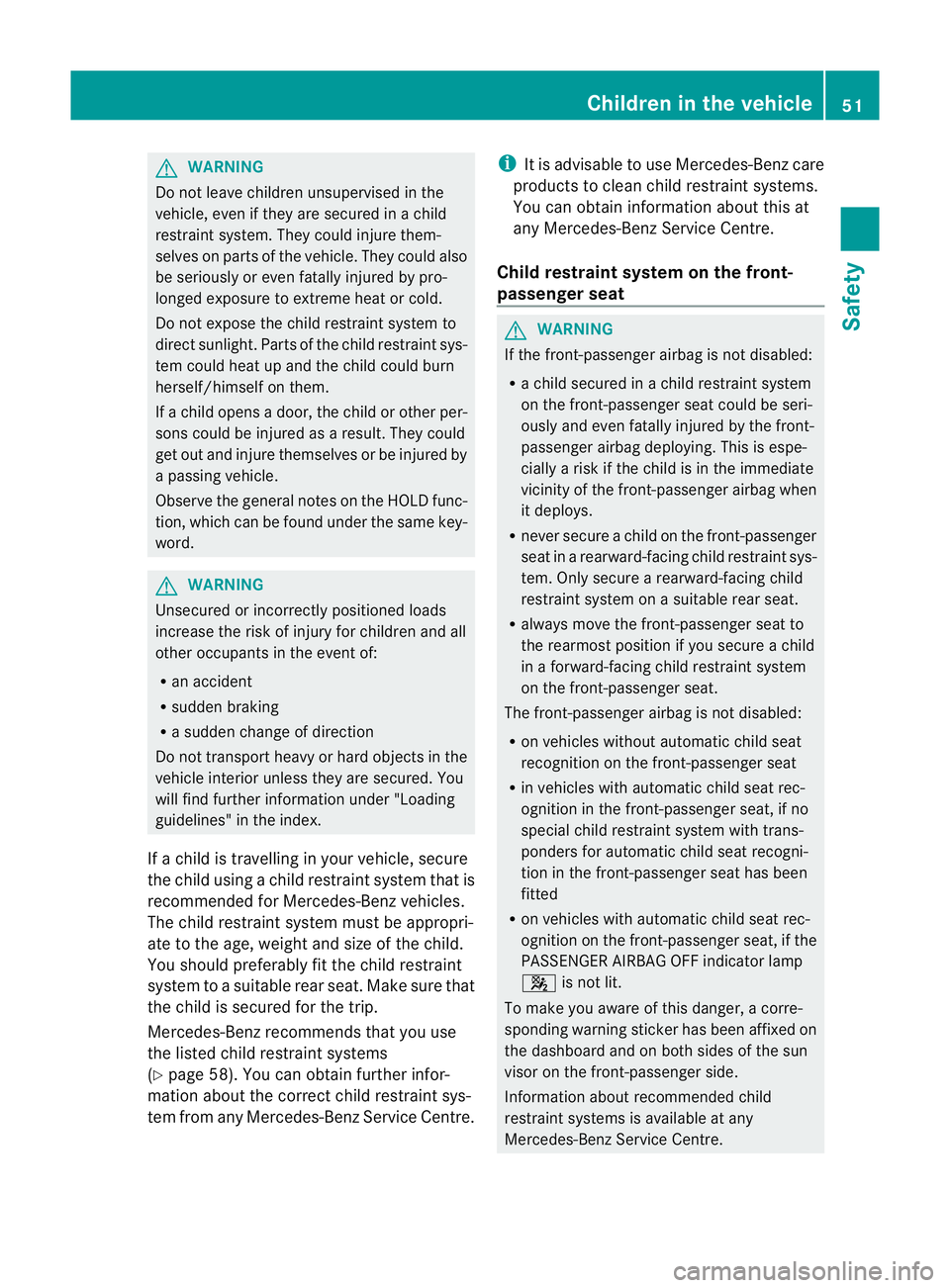
G
WARNING
Do not le avec hildren unsupervised in the
vehicle, even if they ar esecur edinac hild
restraint system .They could injur ethem-
selv eson parts of the vehicle. They could also
be seriously or even fatally injure dbypro-
longe dexpos uretoe xtreme hea torcold.
Do not expose the child restraint system to
direct sunlight. Part softhe chil drestraint sys-
tem could heat up and the child could burn
herself/himself on them.
If ac hild opens adoor, the child or other per-
sons coul dbeinjured as aresult. They could
get out and injure themselves or be injured by
ap assing vehicle.
Observe the general notes on the HOLD func-
tion, which can be found under the same key-
word. G
WARNING
Unsecured or incorrectly positioned loads
increase the risk of injury for children and all
other occupant sinthe even tof:
R an accident
R sudden braking
R as udden change of direction
Do not transpor theavy or hard objects in the
vehicle interior unless they are secured. You
will fin dfurther information under "Loading
guidelines" in the index.
If ac hild is travellin ginyour vehicle, secure
the child using achild restraint system that is
recommended for Mercedes-Ben zvehicles.
The child restraint system must be appropri-
ate to the age, weight and size of the child.
You should preferabl yfit the child restraint
system to asuitable rear seat. Make sure that
the child is secured for the trip.
Mercedes -Benz recommends that you use
the listed child restraint systems
(Y page 58). You can obtain further infor-
mation about the cor rect chil drestraint sys-
tem from any Mercedes-Benz Ser vice Centre. i
It is advisabl etou se Mercedes-Ben zcare
product stoclean child restraint systems.
You can obtain information about this at
any Mercedes-Benz Service Centre.
Child restraint system on the front-
passenger seat G
WAR
NING
If the front-passenge rairbag is not disabled:
R ac hild secured in achild rest raint system
on the front-passenger seat could be seri-
ously and even fatally injured by the front-
passenger airbag deploying. This is espe-
cially arisk if the child is in the immediate
vicinit yofthe front-passenger airbag when
it deploys.
R never secur eachild on the front-passenger
seat in arearward-facing child restraint sys-
tem. Only secur earearward-facing child
restraint system on asuitable rear seat.
R alway smove the front-passenger seat to
the rearmost position if you secur eachild
in af orward-facing child rest raint system
on the front-passenger seat.
The front-passenger airbag is not disabled:
R on vehicles without automatic child seat
recognition on the front-passenger seat
R in vehicles with automatic child seat rec-
ognition in the front-passenger seat, if no
special child restraint system with trans-
ponders for automatic child seat recogni-
tion in the front-passenger seat has been
fitted
R on vehicles with automatic child seat rec-
ognition on the front-passenger seat, if the
PASSENGER AIRB AGOFF indicator lamp
4 is not lit.
To make you aware of this danger, acorre-
spondin gwarning sticker has been affixed on
the dashboard and on both sides of the sun
visor on the front-passenger side.
Information about recommended child
restraint systems is available at any
Mercedes-Benz Service Centre. Children in th
evehicle
51Safety Z
Page 59 of 441
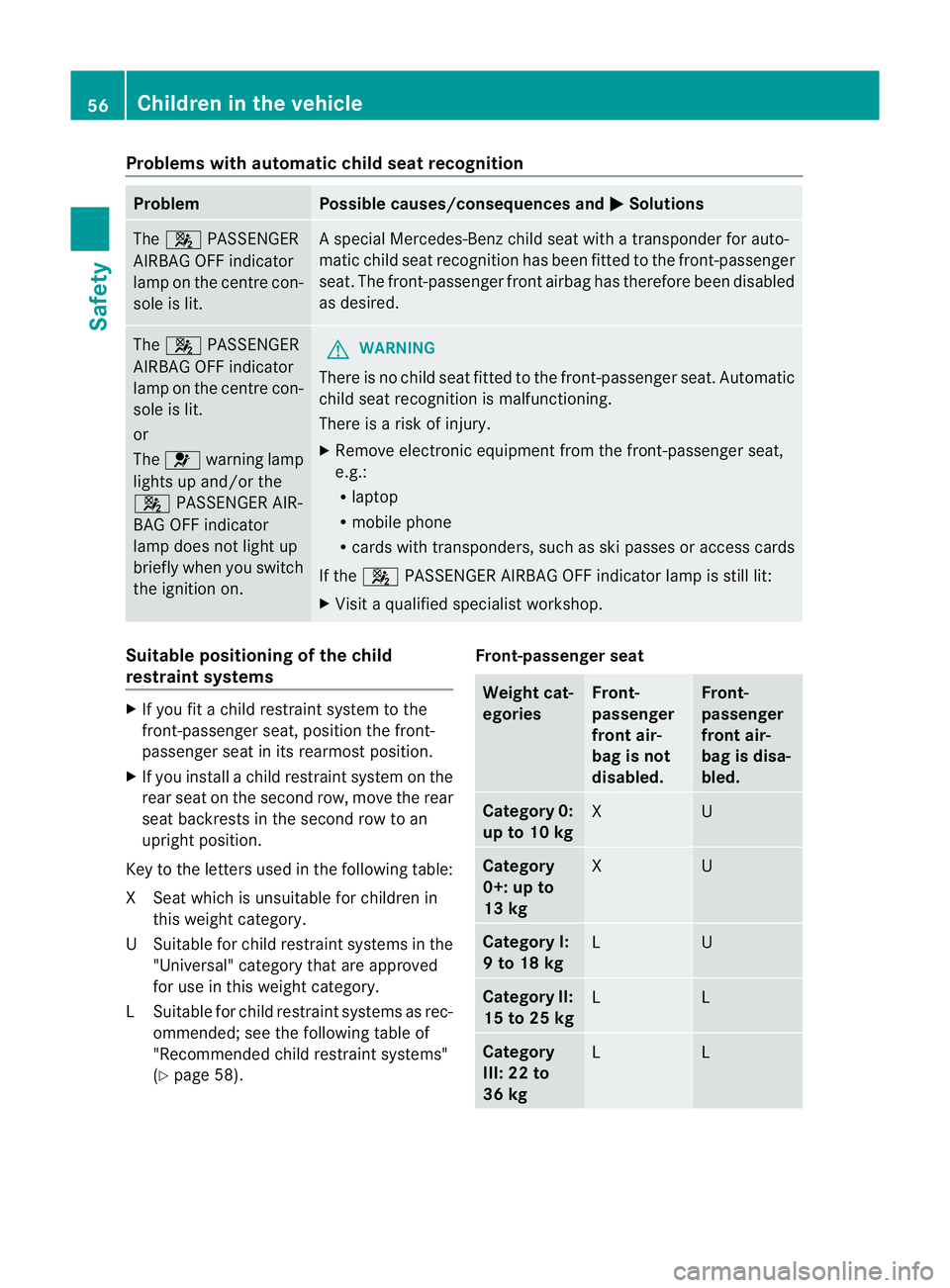
Problems wit
hautomatic chil dseat recognition Problem Possible causes/consequences and
M Solutions
The
4 PASSENGER
AIRB AGOFF indicator
lam ponthe cen trecon-
sole is lit. As
pecial Mercedes-Benz child seat with atransponde rfor auto-
matic child seat recognition has been fit tedtot he front-passenger
seat. The front-passenger fron tairbag has therefore been disabled
as desired. The
4 PASSENGER
AIRBA GOFF indi cator
lamp on the centr econ-
sole is lit.
or
The 6 warnin glamp
lights up and/or the
4 PASSENGER AIR-
BA GO FF indi cator
lamp doe snot light up
briefly when you switch
the ignition on. G
WARNING
There is no child seat fitted to the fr ont-passengerseat .Automatic
child seat recognition is malfunctioning.
There is arisk of injur y.
X Remove electronic equipment from the front-passenger seat,
e.g.:
R
laptop
R mobil ephone
R card switht ransponders, such as sk ipasses or accessc ards
If the 4 PASSENGER AIRBAG OFF indicator lamp is still lit:
X Vis itaq uali fieds pecialist workshop. Suitable positioning of the child
restraint syste
ms X
Ifyou fit achild restraint system to the
front-passenger seat, position the front-
passenger seat in its rearmos tposition.
X If you install achild rest raint system on the
rear seat on the second row, move the rear
seat backrest sinthe secon drow to an
upright position.
Key to the letters used in the following table:
XS eat which is unsuitable for children in
this weight category.
US uitable for child rest raint systems in the
"Universal" categor ythat ar eapproved
for use in this weigh tcategory.
LS uitable for child rest raint systems as rec-
ommended; see th efollowin gtable of
"Recommended child restraint systems"
(Y page 58). Front-passenger seat Weight cat-
egories Front-
passenger
front air-
bag is not
disabled. Front-
passenger
front air-
bag is disa-
bled.
Categor
y0:
up to 10 kg X U
Cate
gory
0+: up to
13 kg X U
Category I:
9to18kg
L U
Category II:
15 to 25 kg
L L
Category
III: 22 to
36 kg
L L56
Children in the vehicleSafety
Page 60 of 441
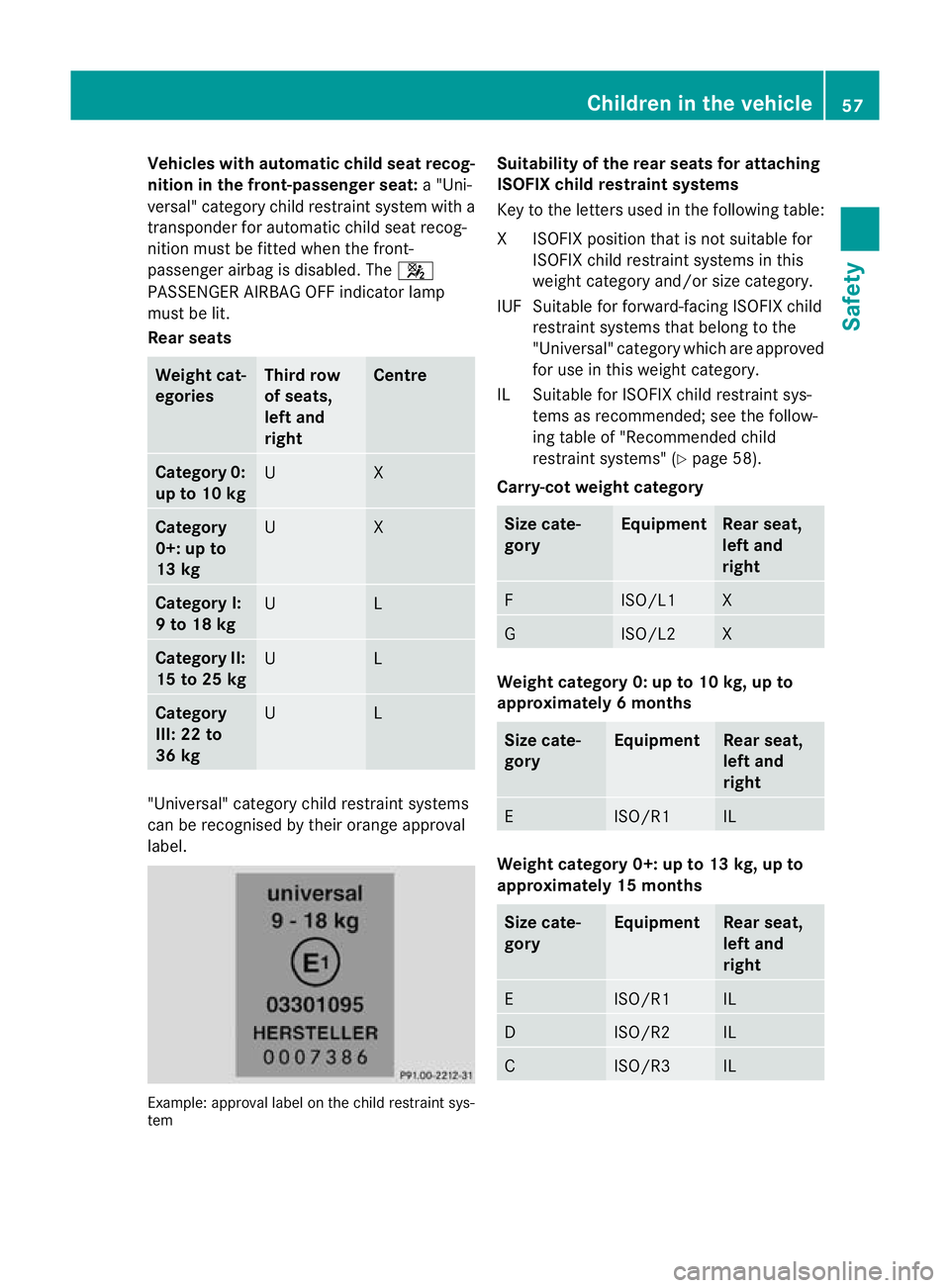
Vehicles with automati
cchild seat recog-
nitio nint he front-pas senger seat:a"Uni-
versal" category child res train tsystem with a
transponder for automatic child seat recog-
nition must be fitted when the front-
passenger airbag is disabled. The 4
PAS SENG ER AIRBA GOFFindicator lamp
must be lit.
Rea rseats Weight cat-
egories Thir
drow
of seats,
left and
right Centre
Categor
y0:
up to 10 kg U X
Cate
gory
0+: up to
13 kg U X
Category I:
9to18kg
U L
Category II:
15 to 25 kg
U L
Category
III: 22 to
36 kg
U L
"Univ
ersal" categor ychild restra ints ystems
can be recognised by their orange approval
label. Example
:approval label on the child restrain tsys-
tem Suitability of the rear seats for attaching
ISOFIX child restraint systems
Key to the letters used in the following table:
XI
SOFIX position tha tisnot suitable for
ISOFI Xchild restraint system sinthis
weight category and/or size category.
IU FS uitable for forward-facing ISOFIX child
restraint systems that belong to the
"Universal" category which are approved
for use in this weigh tcategory.
IL Suitable for ISOFI Xchild restraint sys-
tem sasr ecommended; see the follow-
ing table of "Recommended child
restraint systems" (Y page 58).
Carry -cot weight category Size cate-
gory Equipment Rear seat,
left and
right
F ISO/L1 X
G ISO/L2 X
Weight category 0: up to 10 kg, up to
approximately
6months Size cate-
gory Equipment Rear seat,
left and
right
E ISO/R1 IL
Weight category 0+: up to 13 kg, up to
approximately 15 months
Size cate-
gory Equipment Rear seat,
left and
right
E ISO/R1 IL
D ISO/R2 IL
C ISO/R3 ILChildren in the vehicle
57Safety Z
Page 61 of 441
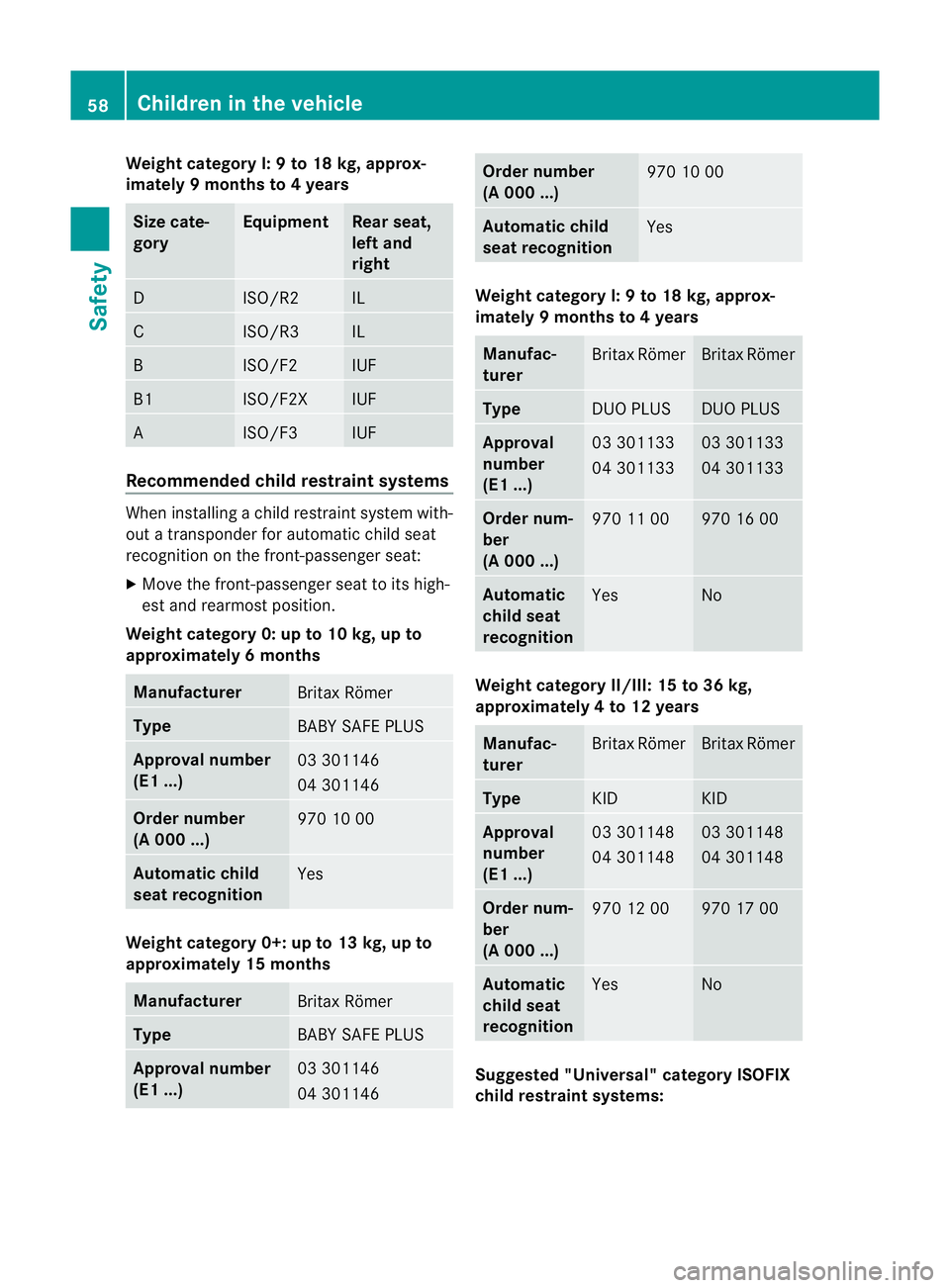
Wei
ghtc ategory I: 9to18kg, approx-
imately 9months to 4years Size cate-
gory Equipment Rear seat,
left and
right
D ISO/R2 IL
C ISO/R3 IL
B ISO/F2 IUF
B1 ISO/F2X IUF
A ISO/F3 IUF
Recommended chil
drestraint systems When installing
achild restraint system with-
out atransponde rfor automatic child seat
recognition on the front-passenger seat:
X Move the front-passenger seat to its high-
est and rearmost position.
Weight categor y0:upto10kg, up to
approximately 6months Manufacturer
Britax Römer
Type
BAB
YSAFEP LUS Approval number
(E
1. ..) 03 301146
04 301146
Orde
rnumber
(A 00 0...) 97
01000 Automatic child
seat recognition
Yes
Weight category 0+: up to 13 kg, up to
approximately 15 months
Manuf
acturer Britax Römer
Type
BAB
YSAFEP LUS Approval number
(E
1. ..) 03 301146
04 301146 Orde
rnumber
(A 00 0...) 97
01000 Automatic child
seat recognition
Yes
Weight category I:
9to18kg, approx-
imately 9months to 4years Manufac-
turer
Britax Römer Britax Römer
Type
DUO PLUS DUO PLUS
Approval
number
(E1 ...)
03 301
133
04 301133 03 301133
04 301133
Orde
rnum-
ber
(A 00 0...) 97
01100 970 16 00
Automatic
chil
dseat
recognition Yes No
Weight category II/III: 15 to 36 kg,
approximately
4to12years Manufac-
turer
Britax Römer Britax Römer
Type
KID KID
Approval
number
(E1 ...)
03 301
148
04 301148 03 301148
04 301148
Orde
rnum-
ber
(A 00 0...) 97
01200 970 17 00
Automatic
chil
dseat
recognition Yes No
Suggested "Universal" category ISOFIX
child restraint systems:58
Children in the vehicleSafety
Page 62 of 441
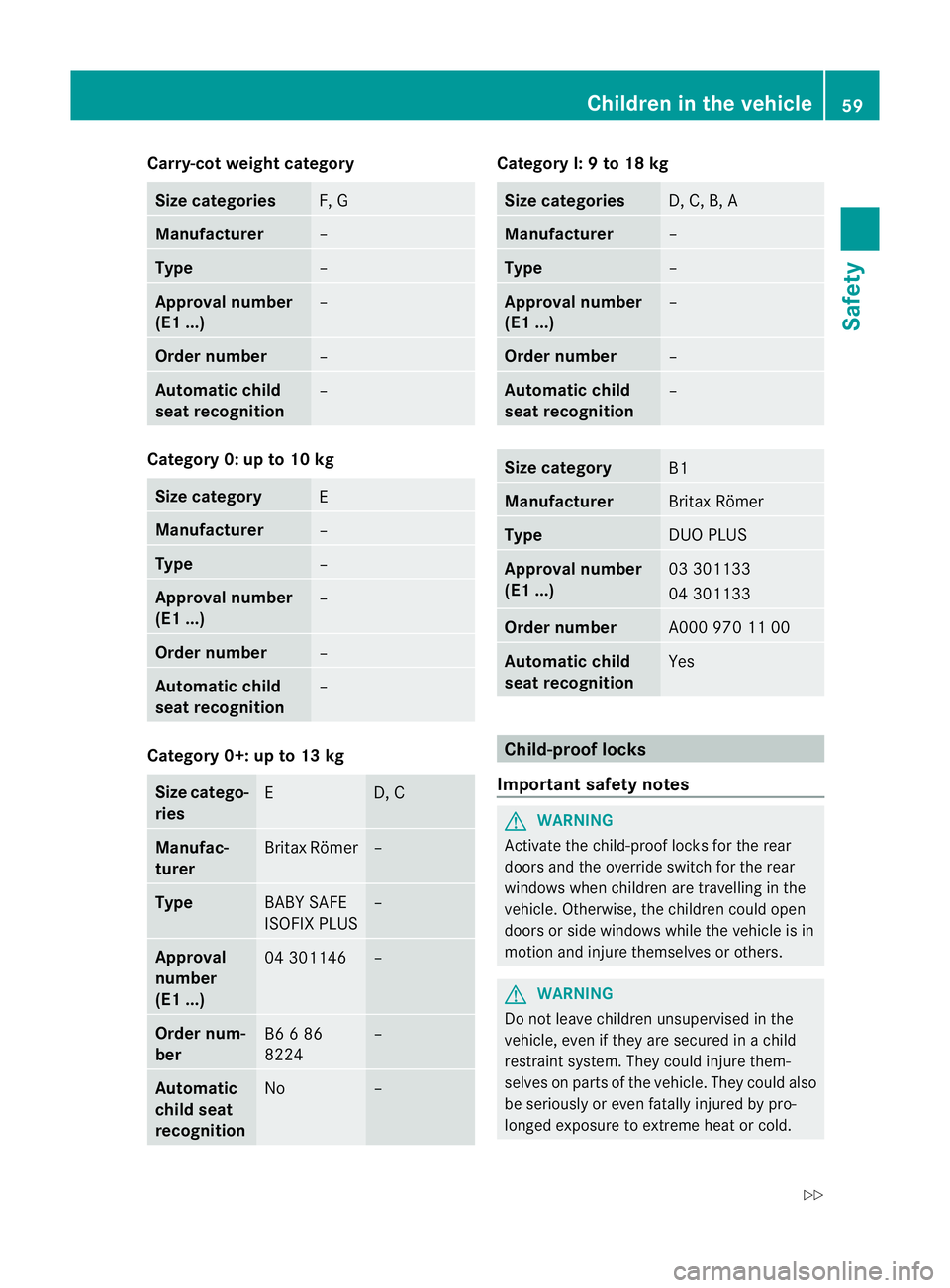
Carry-cot weight category
Size categories
F, G
Manufacturer
–
Type
–
Approva
lnumber
(E1 ...) –
Order number
–
Automatic child
seat recognition
–
Category 0: up to 10 kg
Size category
E
Manufacturer
–
Type
–
Approval number
(E1 ...)
–
Order number
–
Automatic child
seat recognition
–
Category 0+
:upto13kg Siz
ecatego-
ries E D, C
Manufac-
turer
Brita
xRömer –
Type
BABY SAFE
ISOFIX PLUS –
Approval
number
(E1 ...)
04 301146 –
Order num-
ber
B6
686
8224 –
Automatic
chil
dseat
recognition No – Categor
yI:9to18kg Siz
ec ategories D, C, B, A
Manufacturer
–
Type
–
Approval number
(E1 ...)
–
Order number
–
Automatic child
seat recognition
–
Si
ze category B1
Manufacturer
Britax Römer
Type
DU
OP LUS Approval number
(E
1. ..) 03 301133
04 301133
Order number
A000 97
01100 Automatic child
seat recognition
Yes
Child-proof locks
Important safety notes G
WARNING
Activate the child-proof lock sfor th erear
door sand the override switch for the rear
windows whe nchildr en are travel ling in the
vehicle. Otherwise, the children could open
doors or sid ewindows while the vehicle is in
motion and injur ethemselves or others. G
WARNING
Do not leave children unsu pervis edin the
vehicle, even if they are secured in achild
restraint system .They coul dinjure them-
selve sonp arts of the vehicle. They could also
be seriousl yoreven fata llyi njured by pro-
longed exposure to extreme hea torcold. Children in the vehicle
59Safety
Z
Page 79 of 441
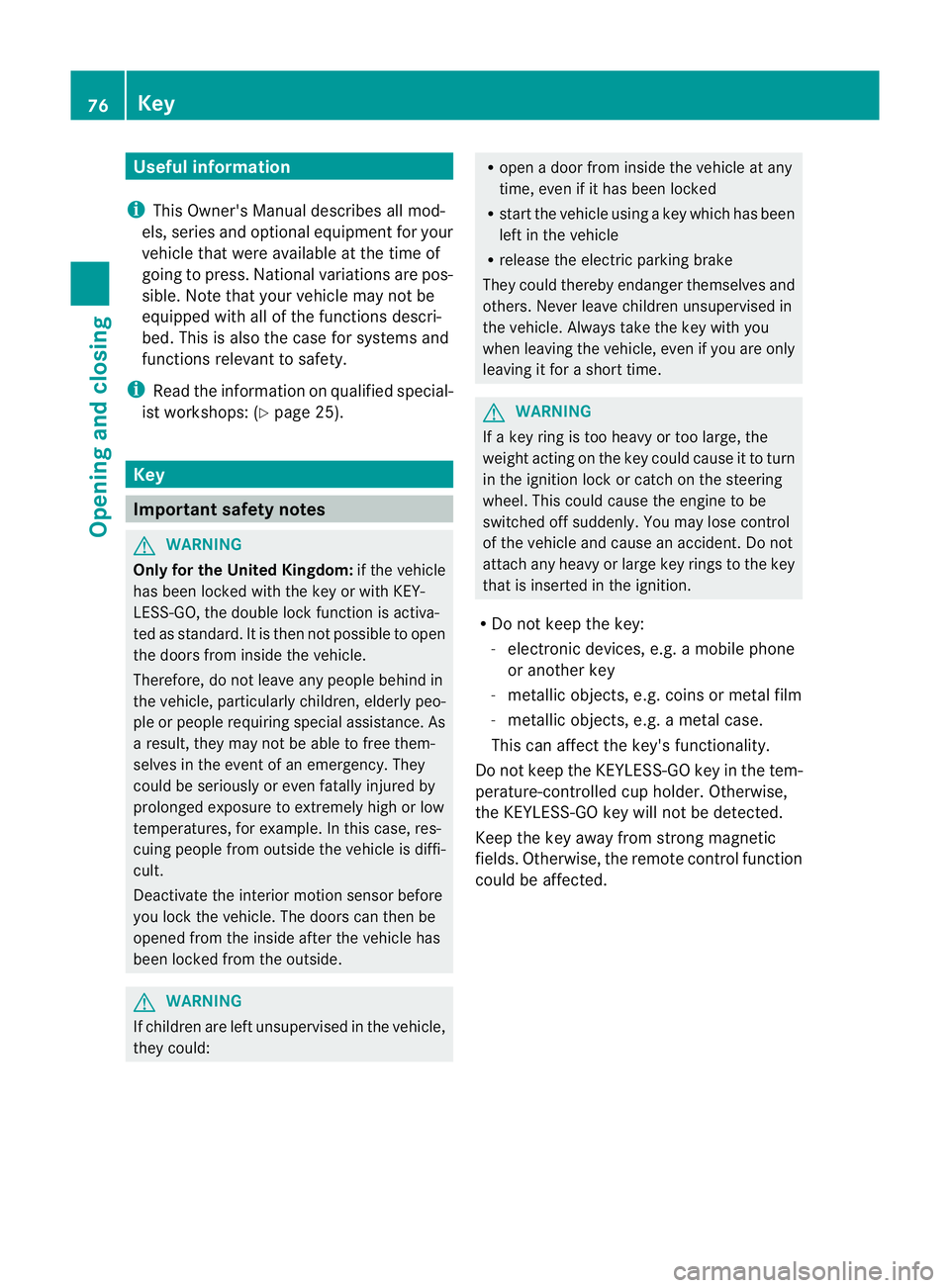
Usefu
linfor mati on
i This Owner's Manual describes all mod-
els, series and optional equipment for your
vehicle that were available at the time of
going to press. National variation sare pos-
sible. Note that your vehicl emay not be
equippe dwith all of the function sdescri-
bed. This is also the case for system sand
functions relevant to safety.
i Read the information on qualified special-
ist workshops: (Y page25). Key
Impo
rtantsafety notes G
WARNING
Only for the Unite dKingdom: if the vehicle
has been locked with the key or with KEY-
LESS-GO, the double lock function is activa-
ted as standard. It is then not possible to open
the doors from inside the vehicle.
Therefore, do not leave any people behind in
the vehicle, particularly children ,elderly peo-
ple or people requirin gspecial assistance. As
ar esult, they may not be able to free them-
selves in the even tofanemergency. They
could be seriously or eve nfatally injured by
prolonged exposure to extremely high or low
temperatures, for example. In this case, res-
cuing peopl efrom outsid ethe vehicle is diffi-
cult.
Deac tivate th einterior motion sensor before
you lock the vehicle. The doors can then be
opened from the inside after the vehicl ehas
been locked from the outside. G
WARNING
If children are left unsupervised in the vehicle,
they could: R
open adoor from inside the vehicle at any
time, even if it has been locked
R star tthe vehicle usin gakey which has been
left in the vehicle
R release the electric parking brake
They could thereby endanger themselves and
others. Never leave children unsupervised in
the vehicle. Alway stake the key with you
when leaving the vehicle, even if you are only
leaving it for ashort time. G
WARNING
If ak ey rin gistoo heavy or too large, the
weight actin gonthe key coul dcause it to turn
in the ignition lock or catc honthe steering
wheel. This coul dcause the engine to be
switched off suddenly. You may lose control
of the vehicle and cause an accident. Do not
attac hany heavy or large key rings to the key
that is inserted in the ignition.
R Do not keep the key:
-electronic devices, e.g. amobile phone
or anothe rkey
- metallic objects, e.g. coins or metal film
- metallic objects, e.g. ametal case.
This can affect the key' sfunctionality.
Do not keep the KEYLESS-GO key in the tem-
perature-controlled cup holder. Otherwise,
the KEYLESS-GO key will not be detected.
Keep the key away from strong magnetic
fields. Otherwise, the remot econtrol function
coul dbea ffected. 76
KeyOpenin
gand closing
Page 260 of 441
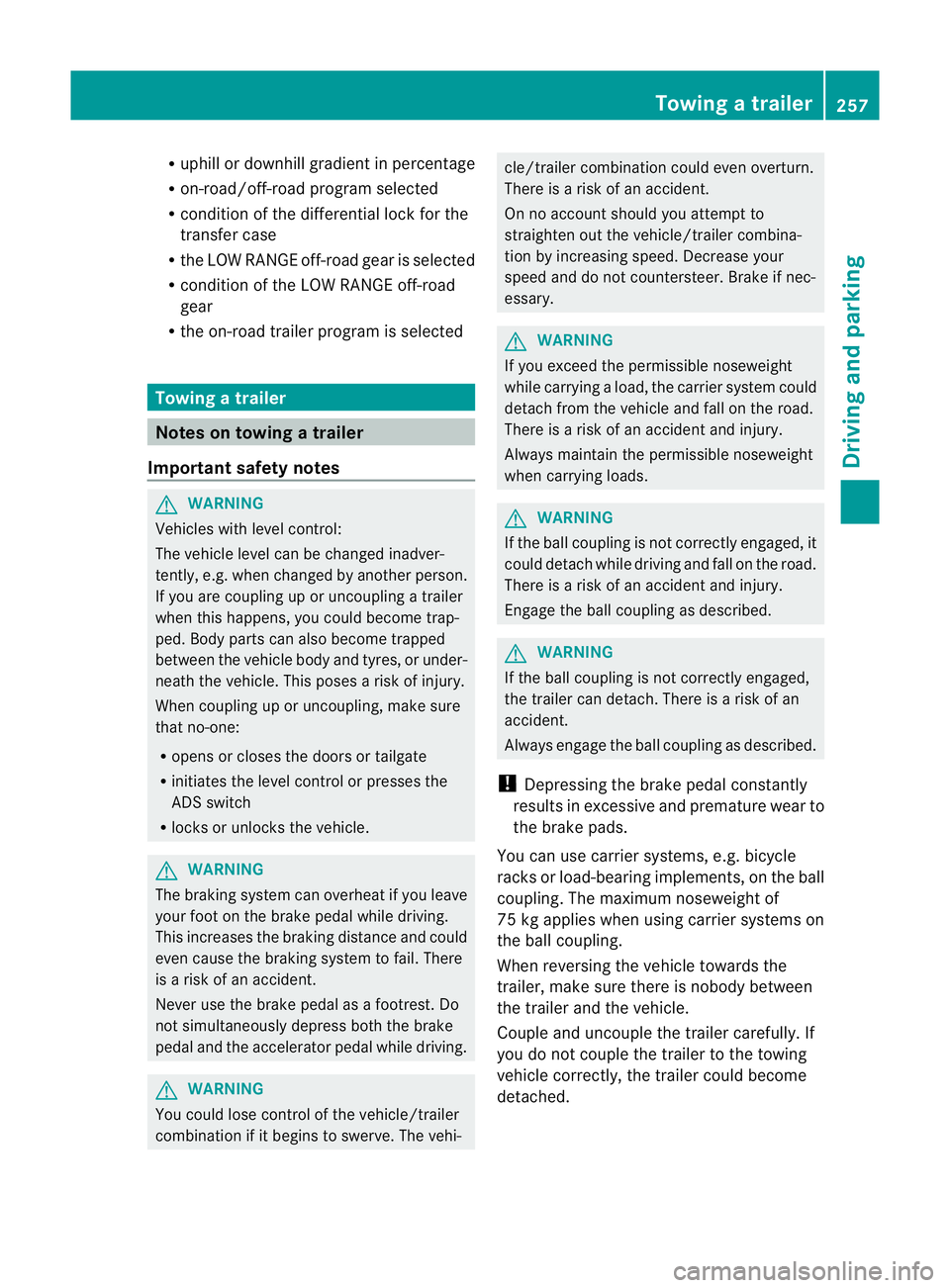
R
uphill or downhill gradien tinpercentage
R on-road/off-road program selected
R condition of the differential lock for the
transfer case
R the LOW RANGE off -road gear is selected
R condition of the LOW RANGE off -road
gear
R the on-roa dtrailer progra misselected Towing
atrailer Note
sont owingatrailer
Important safety notes G
WARNING
Veh icle sw ithl evel control:
Th ev ehicle level can be change dinadver-
tently, e.g. whe nchanged by anot her person.
If yo uare coupling up or uncoupling atrailer
when this happens ,you coul dbecom etrap-
ped. Bod yparts can also become trapped
between the vehicle body and tyres, or under-
neath the vehicle. This pose sarisk of injury.
When coupling up or uncoupling, make sure
that no-one:
R opens or closes the doors or tailgate
R initiates the level control or presses the
AD Ss witch
R locks or unlock sthe vehicle. G
WARNING
The brakin gsystem can overheat if you leave
your foot on the brake pedal while driving.
This increase sthe brakin gdistanc eand could
even cause the braking system to fail. There
is ar isk of an accident.
Never use the brake pedal as afootrest. Do
not simultaneously depress both the brake
pedal and the accelera torp edal while driving. G
WAR
NING
You could los econtrol of the vehicle/trailer
combination if it begins to swerve. The vehi- cle/
trailer combination could even overturn.
There is arisk of an accident.
On no account should you attempt to
straighten out the vehicle/trailer combina-
tion by increasing speed. Decrease your
speed and do not countersteer .Brake if nec-
essary. G
WARNING
If you excee dthe permissible noseweight
while carrying aload, the carrier system could
detac hfrom th evehicle and fall on the road.
There is arisk of an acciden tand injury.
Always maintain the permissible noseweight
whe ncarrying loads. G
WARNING
If the ball coupling is not correctly engaged ,it
coul ddetac hwhile drivin gand fall on the road.
There is arisk of an acciden tand injury.
Engag ethe ball coupling as described. G
WARNING
If the ball coupling is not cor rectly engaged,
the traile rcan detach. There is arisk of an
accident.
Always engage the ball coupling as described.
! Depressing the brake pedal constantly
results in excessive and premature wear to
the brake pads.
You can use carrier systems, e.g. bicycle
rack sorload-bearing implements, on the ball
coupling. The maximum noseweight of
75 kg applies when using carrier system son
the ball coupling.
Whe nreversin gthe vehicle towards the
trailer ,make sure there is nobody between
the trailer and the vehicle.
Couple and uncouple the trailer carefully. If
you do not couple the trailer to the towing
vehicle correctly, the trailer could become
detached. Towin
gatrailer
257Driving an dparking Z
Page 261 of 441
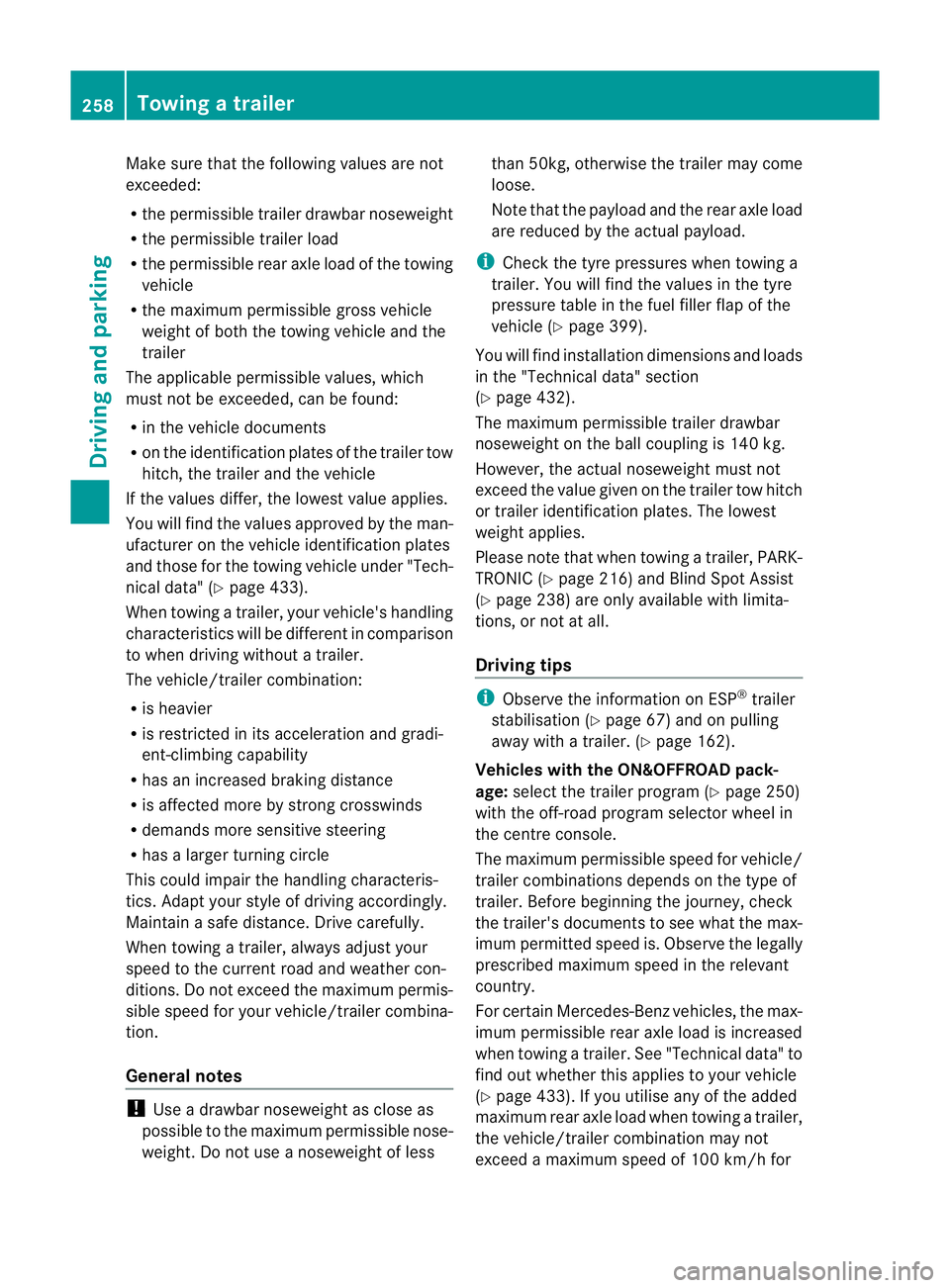
Make sur
ethat the followin gvalues are not
exceeded:
R the permissible trailer drawba rnoseweight
R the permissible trailer load
R the permissible rea raxle load of the towing
vehicle
R the maximum permissible gros svehicle
weight of both the towing vehicle and the
trailer
The applicable permissible values, which
must not be exceeded, can be found:
R in the vehicle documents
R on the identification plates of the trailer tow
hitch, the trailer and the vehicle
If the values differ, the lowest value applies.
You will fin dthe values approved by the man-
ufacturer on the vehicle identification plates
and those for the towing vehicle under "Tech-
nical data "(Ypage 433).
When towing atrailer, your vehicle's handling
characteristics wil lbedifferent in comparison
to when drivin gwithout atrailer.
Th ev ehicle/ trailer combination:
R is heavier
R is restricted in its acceleration and gradi-
ent-climbin gcapability
R has an increased braking distance
R is affected more by stron gcrosswinds
R demand smore sensitive steering
R has alarger turnin gcircle
This could impair the handling charac teris-
tics. Adapt your styl eofdriving accordingly.
Maintain asafe distance. Drive carefully.
When towing atrailer, alw aysa djust your
speed to the current road and weather con-
ditions. Do not exceed the maximum permis-
sible speed for your vehicle/trailer combina-
tion.
General notes !
Use adrawbar noseweigh tasc lose as
possible to the maximum permissible nose-
weight. Do not use anoseweight of less than 50kg, otherwise the trailer ma
ycome
loose.
Not ethat the payload and the rea raxle load
are reduce dbythe actual payload.
i Chec kthe tyr epressures when towin ga
trailer. You will find the values in the tyre
pressure table in the fuel filler flap of the
vehicle (Y page 399).
You will find installation dimensions and loads
in the "Technical data" section
(Y page 432).
The maximum permissible trailer drawbar
noseweight on the ball coupling is 140 kg.
However, the actual noseweight must not
exceed the value given on the trailer tow hitch
or trailer identification plates .The lowest
weight applies.
Please not ethat when towing atrailer, PARK-
TRONIC (Y page 216) and Blind Spo tAssist
(Y page 238) ar eonly available with limita-
tions ,orn ot at all.
Driving tips i
Observ ethe information on ESP ®
trailer
stabilisation (Y page 67)and on pulling
away with atrailer. (Y page 162).
Vehicle swith the ON&OFFROAD pack-
age: select the trailer program (Y page 250)
with the off- road program selector wheel in
the centre console.
The maximum permissible spee dfor vehicle/
trailer combina tions depends on the type of
trailer .Befor ebeginning the journey, check
the trailer's document stosee what the max-
imu mpermitted speed is. Observ ethe legally
prescribed maximum speed in the relevant
country.
For cer tain Mercedes-Benz vehicles, the max-
imum permissible rear axle load is increased
when towing atrailer. See "Technica ldata" to
find out whethe rthis applies to your vehicle
(Y page 433). If you utilise any of the added
maximum rea raxle load whe ntowing atrailer,
th ev ehicle/ trailer combination may not
exceed amaximum spee dof100 km/h for 258
Towin
gatrailerDriving an dparking